
Not soon after I sold my Imola Red DINAN M Roadster, a few of my friends started asking me about my next car purchase. I had just sold my car after two years of ownership and countless hours of restoration and service work and I started questioning why I put it up for sale in the first place. I had really enjoyed owning, restoring and driving my M Roadster, but the time had come to let go of the little red roadster, even if I was selling it for less than what I had invested in it. I was ready to focus on other non- car related projects.
But I couldn’t help but log on to Mroadsterbuyersguide.com to see what the going market prices were for similar mileage cars as the one I just sold. At the same time a few people sent me leads on possible project cars nearby. The market for these cars is holding steady and in some cases, rare colored cars and low mileage examples are trading hands at new highs. The M Coupes still garner the most demand and they have higher asking prices, but the M Roadsters have obtained a following as well. The issue with any car that’s around 15 years old, as most of these cars are, is that they need some attention, either mechanically or cosmetically. The M Roadster was introduced in 1998, so those early models are now 17 years old! Regardless of the mileage, 17 years takes its toll on motor mounts, suspension bushings and transmission seals. Leather seats, canvas tops and plastic molding can also show their age depending on climate and use. All of these factors can quickly add up to thousands of dollars in repair costs at the mechanic. But, if you can address these items yourself, you can find really good values with clean examples that just need a little refreshing.
So taking all of this into account, you can imagine my peaked interest when I came across a completely stock, matching numbers Titanium Silver 2000 M Roadster with 73k miles with an asking price of $5k less than what I had just sold my DINAN modified 1999 M Roadster with 68k miles. Now to be fair, the car I had just sold had a ridiculous amount of new parts, services and upgrades put into it and included a hardtop, and new Roadstar wheels and tires. But I couldn’t help think of the possibilities and the fun I’d have driving this new car down to SoCal from Seattle.
So long story short, within a week I had done my pre-purchase due diligence, then I flew up to conduct the in-person inspection, and soon after I drove her home. Now I need to figure out what to do with her. My fix-it-list always starts on the day of purchase with the walk around, where I notice mostly cosmetic items that need attention. The next way to add items to my to do list is while I’m driving the car home. In this particular case I had 1,200 miles to test everything out and to find all the little things that needed attention. Then, when I finally arrive home I conduct a fairly thorough 100+ point inspection of the exterior, interior, engine bay, undercarriage, axles, etc.
When I initially saw the car in person after landing in Seattle, my first impression was that the car’s paint was in really good condition, with no major wear or rock chips. The lower front bumper had a few scrapes, which are common, but nothing too unsightly. The rear wheels had a few scrapes, which is very common and easily addressed by a good wheel repair shop. The top and rear window were both in great condition. The owner always used the BMW blanket to protect the rear plastic window when he put the top down. The interior was very clean, with no damage or major wear to the black leather seats or the door panels. The seats were still very supportive and had plenty of cushion in them. The engine bay was spotless and there were no signs of leakage or wear. The car had been serviced regularly and the owner had cleaned the engine bay every time he washed the car. Inside the trunk, the carpeting was lifted up and the subframe was inspected and found to be in perfect condition. All tools were present, as was the factory pump. Remember…no spare tire or jack in this car!


Once on the road, I could really see what needed attention. Heading down the I-5 out of Seattle towards SoCal, I had roughly 18 hours of seat time ahead of me to find every issue the car had. The very first thing I noticed was the automatic dimming rear view mirror had gone bad, limiting visibility. This is a very common problem with 99 model year and up cars. Next, the bushings in the drivers seat were just a little lose under hard breaking. They weren’t completely gone, as is usually the case with these cars, but you would notice a little movement in the base of the seat now and again. The glove box was a little lose, no surprise. And one of the center console gauges needed a new light bulb. Other than that everything worked great, looked great and didn’t give me any trouble. Even the lighted shifter knob worked!
Of course it wasn’t all perfect; Just a few minutes after leaving Seattle the car put up a check engine light. I had my OBD-2 reader close by and ready for such an occasion, so it wasn’t a big deal. The error code referred to a bad oxygen sensor, which the previous owner had warned me about. I reset the error code and every 400 miles or so it would come back on again until I reached home.
Once the car was home, the real inspection started. First I gave the car a thorough hand wash to get all the dead bugs off the front end. Once clean, it was time to see what I really had. I started by checking all of the VIN stickers on the body panels and I confirmed that it was a numbers matching car all around. Next stop was putting the car on a lift and inspecting the chassis and drivetrain. First inspection point was the underside of the rear subframe, specifically the differential mount. Everything looked perfect with no signs of cracks, stressed metal or popped welds. There were no signs of rust or oil seepage on the differential, engine or shocks and struts. The transmission did have slight oil seepage at the top, most likely from the shifter linkage gasket, a common occurrence with cars of this age. All plastic undercarriage parts were present and the underside of the car was surprisingly clean and undamaged. The rotors and pads had plenty of life left in them, although I plan to replace them anyway. The struts and shocks needed to be replaced, as the car rode very high and wasn’t confidence inspiring in the corners.
By this time I had a pretty long list of service items I wanted to replace, but luckily there wasn’t much in terms of repair work that needed to happen. Well, there was the dark colored brake fluid, which was really bothering me, but I decided to hold off on performing a brake bleed just yet, as I planned to also replace the clutch and clutch slave, which will require a flush anyway.